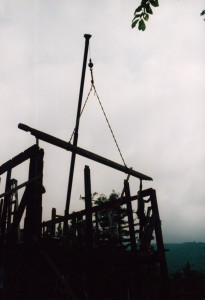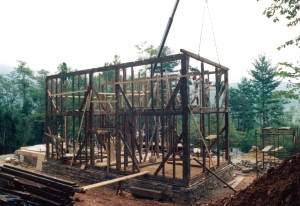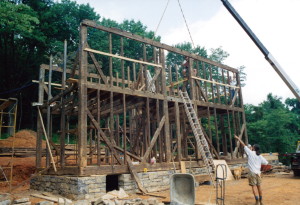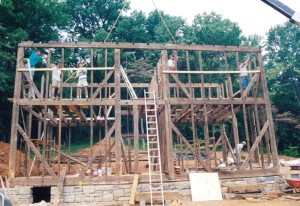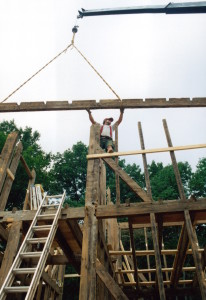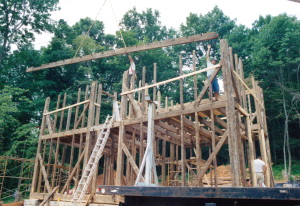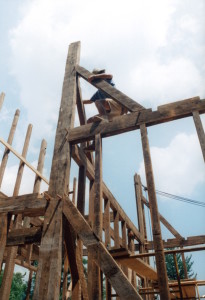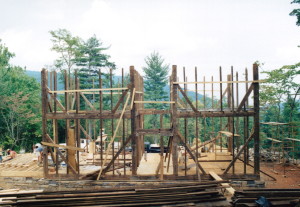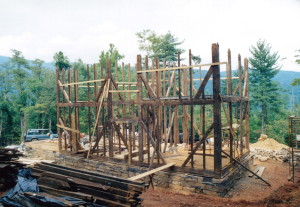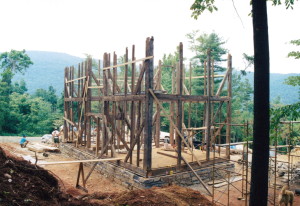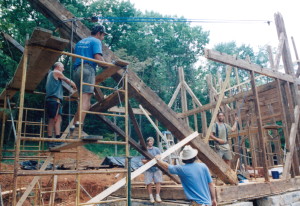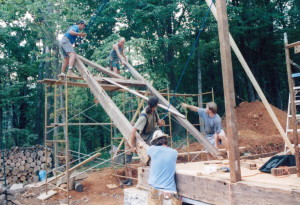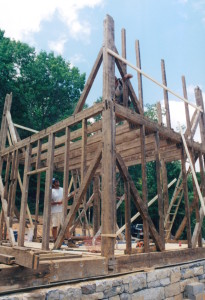Setting the top plate… part 5
Noah Bradley2019-06-29T10:34:12+00:00The problem with the top plate not properly fitting is found.
My foreman points to the area that needs attention.
The top plate then slides into position and it is once again reunited with the home.
And, as an added bonus, I had taken one of the best photos of my career. 🙂
I am reminded of another “life lesson” in looking at this image… one that I have found works well throughout the construction of a house… whenever I encounter a problem rather than hover over it and try to figure it out… I find that I can often solve it by standing back and just take in the bigger picture, and then the solution is often revealed.
Originally posted 2015-04-12 15:38:09.
Setting the top plate… part 2
Noah Bradley2019-06-29T10:34:09+00:00Here we see a man who is clearly, fully, committed to setting this top plate in place. Both hands on a swinging beam. It looks scarier than it was… but still, it takes a special breed of man to do the work we do.
I’ve been running my own restoration/building company now for twenty six years, and other than my broken finger, the most serious injury that I recall on my crew were splinters (we have had our share of them).
And for that, I am so thankful.
Originally posted 2015-04-12 14:40:28.
Setting the top plate… part 1
Noah Bradley2019-06-29T10:34:08+00:00Here we have a forty-four foot long piece of clear heart pine lumber being slowly craned up for the crew to install.
Try walking into a lumber yard and asking for a piece of wood like that. 🙂
The crewman in the middle, seen in this photo, is most eager to touch this treasure.
Originally posted 2015-04-12 14:28:31.
The Sugar Hollow house… part 14
Noah Bradley2019-06-29T10:34:07+00:00Men never fully grow up.
It seems as if there remains inside of each man a little boy.
I have observed through my many years of building unique homes that men love to climb. It’s just part of their nature. Like monkeys, they are.
I’ve got tons of photos similar to this one. Photos that I find that I’m not sure what the crewman is doing, but certainly he is hanging on… and clearly busy.
It doesn’t matter if we were building a timber frame, or if it was a log cabin. Regardless of the project, there are photos throughout my photo box of men hanging onto various timbered structures.
Now keep in mind, that this activity was not brought about because a ladder was unavailable… I always kept an ample supply on site. And I must confess that I was not immune to the “call to climb”… boy, I could tell you some stories in that regard. lol
It is a shame that our world today supplies little opportunity for men to climb as they once did when they were little boys… but I am here to bear witness, that if given the opportunity, eventually all men, will climb.
I’ve also noticed that they smile more broadly when they do.
Originally posted 2015-04-11 17:22:19.
The Sugar Hollow house… part 13
Noah Bradley2019-06-29T10:34:06+00:00Here is a very important set of photos…
There is something in these photos that you really need to SEE. Can you spot it?
It’s most visible in the first photo… the one taken straight on to the house.
At this stage of re-construction we have now set all the vertical members in place. The crane will soon arrive so that we can tie everything together.
The frame will become much more attractive at that point and it will gain a great deal of strength, but the stage of construction that we see here should not be passed by too quickly… there is a secret to be revealed in the design and construction of many early American structures… one that will become much harder to spot as the house is completed.
Yes, the timbers are beautiful (and so is the view). Yes, Virginia corner bracing is incredible… who wouldn’t feel safe in a home built like this? And yes, what a perfect combination of ceiling heights… ten foot ceilings downstairs and eight feet on the second floor.
So, let me give you a hint…
Remember the chestnut log barn re-construction that I shared with you a couple weeks ago?
In order for those men to create a large barn, they built two structures, each of manageable size for the men and the materials. They built those structures close to each other, and then connected them together with a top plate in order to create a large barn.
Well, that is what a Virginia farmhouse is! Two one room structures, each two stories high, that are built close to each other and then a connecting hall is built in between!
Cool huh?
Originally posted 2015-04-11 16:46:23.
The Sugar Hollow house… part 12
Noah Bradley2019-06-29T10:34:05+00:00We re-erected this 200 year old timber-frame in the same way that we took her down… one or two pieces at a time.
We chose to raise by hand all of the vertical members, partially “for the experience”, and partially, to honor the original builders.
When it came time to install the full length top plates, and then tie the structure together with the second floor joists, we brought in a crane.
I imagine this house frame was originally lifted in place in large sections with the aid of many neighbors and perhaps a team of oxen. Today’s insurance regulators wouldn’t think highly of me if I had brought in any neighbors. And, I didn’t have a fresh team of oxen so that option was out too.
Also, I had to keep in mind that I was putting up a different timber-frame than those men of old had assembled… mine was a treasured antique, still strong, but the flexibility of youth was long gone. I did not want to risk the loss of this structure by putting it through the stress of a complete wall lift.
And so, we lifted. We strained. We sweated. We groaned in unison. And, we loved every minute of it.
Originally posted 2015-04-11 16:06:57.
The Sugar Hollow house… part 11
Noah Bradley2019-06-29T10:34:04+00:00Here we have the first floor of one of the timber-framed rooms now standing, and we are busy putting in the smaller framing members that will all be secured once the top plate is installed.
Notice that we did have to do a patch on the bottom sill beam to repair the area below the main door threshold… a spot where rot often occurs, even on new homes.
Notice also that we numbered all these pieces with duck tape… a first for us, and it worked out pretty well.
I swear, duck tape can do anything!
Originally posted 2015-04-10 21:21:09.

